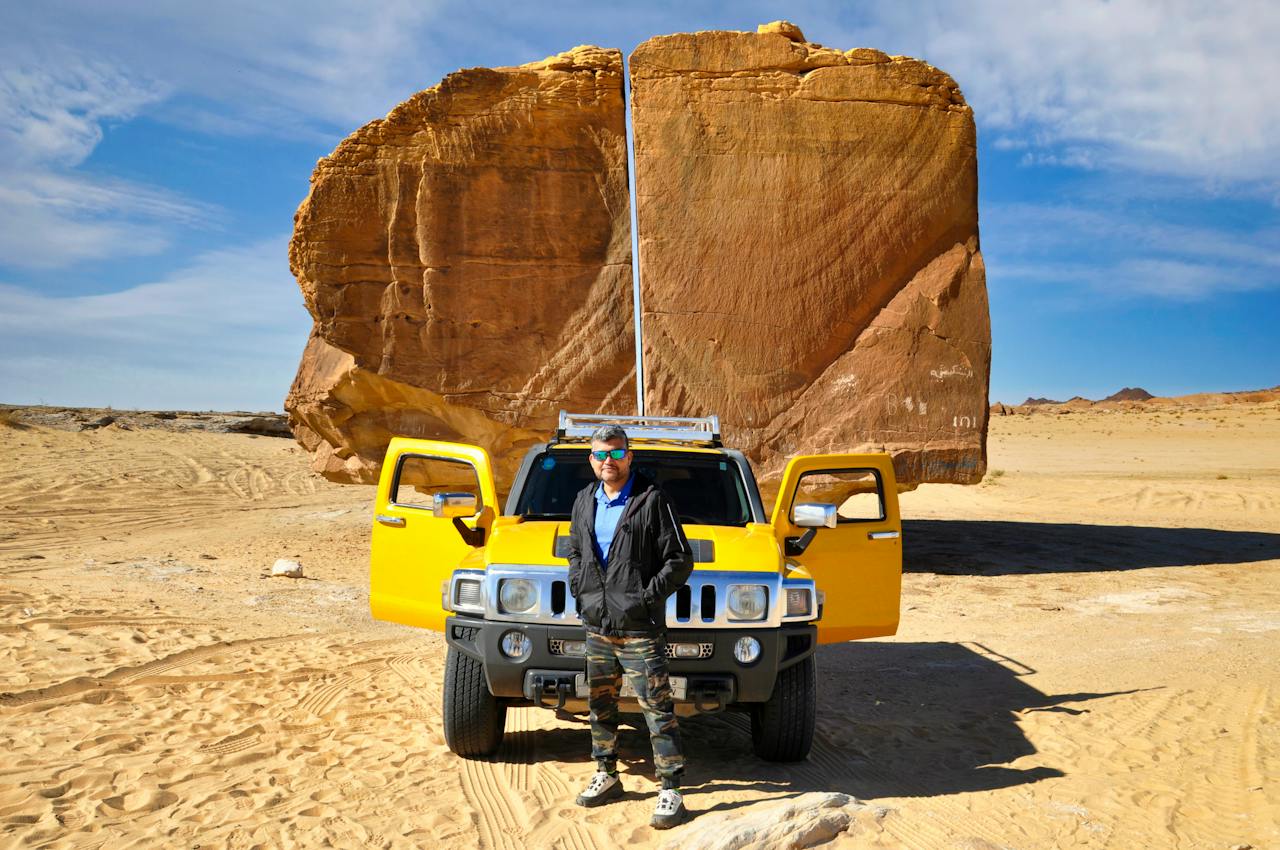A megalith is usually defined as a huge stone that has been carved and shaped to be constructed into a large structure. The megalith of Al-Naslaa, had it not been split into two, would probably have classified as a monolith, which is a single giant stone. And that is why this particular megalith is famous.
Where Is It Situated?
The megalith of Al-Naslaa, also called the Al-Naslaa rock formation, is located in the Tayma Oasis in northwestern Saudi Arabia. Tayma is known to have been inhabited from at least the Bronze Ages, and is popular for the rock art found there and its historic significance. The Al-Naslaa rock formation is one of the most popular and most photographed formations in Tayma, and is admired because of its naturally attained figure (probably).
Its Claim To Fame
The megalith of Al-Naslaa is famous because of the extremely straight gap between it that resembles a precision cut from a laser. The unnaturally natural split has many theories circulating around it, from the reasonable ones regarding tectonic activity to the more farfetched ones about extraterrestrials. Whatever the cause might have been, the split continues to attract photographers and pique people’s curiosity. Almost as noteworthy as the split are the small pedestal-like boulders the two pieces of the formation are standing atop. Interestingly enough, the Al-Naslaa rock formation isn’t actually connected to these boulders, and is merely balanced on top of it.
Possible Causes For The Split
Various causes and explanations have been put forth as to why this split exists. Geologists theorize that the earth below the rock might have shifted at some point in the past and caused the rock to split. They also theorize there could be a fault line under it which might have stressed the rock to a point where it broke.
Explanations for its precise cut also vary. Some think it might have been a fracture that had been slowly pulled apart. Joint fractures in rocks often produce rather straight cuts. In support of this theory, other narrow fissures can also be seen on the rock. These might be new joint fractures that are yet to completely break apart.
As the rock is in a desert, it has also been theorized that the blowing sand might have contributed to the split. Sand blowing in through the forming crack would have eroded this particular spot much faster than the surrounding rock, and helped cause the split.
Unlikely but Popular Causes For The Split
As is tradition, this discovery did not escape the notice of conspiracy theorists and other, more peculiar folk. There has been quite a many speculation on the Al-Naslaa rock formation and there are some that seem to think it was cut with a precision laser. These speculations range from intelligent extraterrestrial life to an ancient advanced race of humans who cut this rock. Why aliens or super smart ancient humans would be interested in cutting open a rock out in the desert is anyone’s guess.
Other Noteworthy Features
Though its straight split is undoubtedly why tourists flock to this area in the thousands each year, the megalith of Al-Naslaa has other interesting features as well. For starters, the boulders we have already mentioned above are pretty interesting if you think about it. It’s quite the sight seeing two huge pieces of a rock balanced on much smaller ones beneath them. How long this balance remains though, is yet to be seen.
Another historically fascinating feature of the megalith is the rock art found on it. There is only one piece of this art on the stone, and nothing about it points to anything about the split. It just seems to be a normal piece of ancient rock art. Judging by the placement of this art, it is both possible that the split existed or did not exist when this art was made.
A Little History
The megalith of Al-Naslaa was discovered in 1883 by a certain Charles Huver, and has been quite a popular topic of debate since then. Situated in Tayma Oasis, a place as old as time and extremely rich in history with possible ties to a Babylonian King, this rock has no doubt been seen and touched by many. When it got its split, or even the rock art on its surface however, is still up for debate.
As it is such an old rock however, apart from the possibilities discussed above, there is also a chance that water erosion might have once played a part in splitting this rock. Unfortunately, most of the details of that era and especially about this rock are hazy at best, and non-existent at best. Simply put, as it currently stands, we just don’t know much about this megalith at the moment.
Conclusion
The megalith of Al-Naslaa is pretty much a mystery, and it seems very unlikely that we will ever figure this curious formation out completely. Nevertheless, perhaps this enigmatic air surrounding it is a good thing, as it keeps the tourists visiting and the theorists theorizing. All in all, mystery or not, geological reasons or drunk aliens, this rock will be famous for a long time. Well, at least until the halves fall down that is.
Interested in reading about some other strange places as well? Check out our list on strange and unusual places that actually exist. Hungry but on a diet? Kill your appetite by checking out these strange foods from around the world.

